When it comes to the tourist spots in Kaifeng, Henan, it should be “Qingming Shangheyuan” that comes to most people’s minds.
But in addition to it, there is another tourism theme park of Chinese ancient culture, which either the scale or the scenery are equally good as it– “Qi Feng Gu Yuan“.
📌 Coupon for Travels!
🏠Accommodation
Agoda(Sale Now!)
Trip.com
Booking.com
Hotels.com(Limit Sale,Save up to 75%!Book 10 nights and get 1 night for FREE!)
✈️Flight
🚩Follow「Kate’s Fun Zone」for more travel info!
A Beautiful Water Town
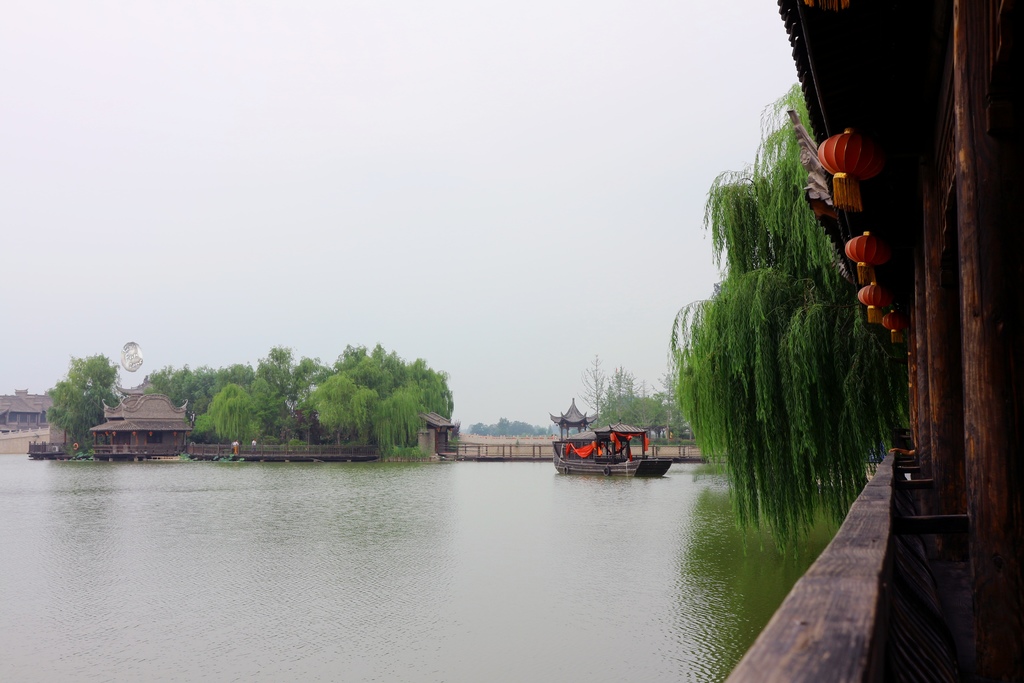
Qifeng Guyuan was the location of Zhuxian Town in the past, which is about 20km south of Kaifeng City. It was listed as the top four major commercial towns in China (the other three are Jingdezhen in Jiangxi, Foshan in Guangdong, and Hankou in Hubei). Because it is located in “Zhongyuan” (Central Plains, the area which formed the cradle of Chinese civilization), it is the center of northern China’s transportation hub.
During Ming and Qing Dynasties, Zhuxian Town reached the peak of prosperity, merchants from all over the country gathered here. Moreover, Chinese New Year wood-block print and Xiangfu tune of Yu opera also originated from here, thus being the hometown of Chinese folk culture and art.
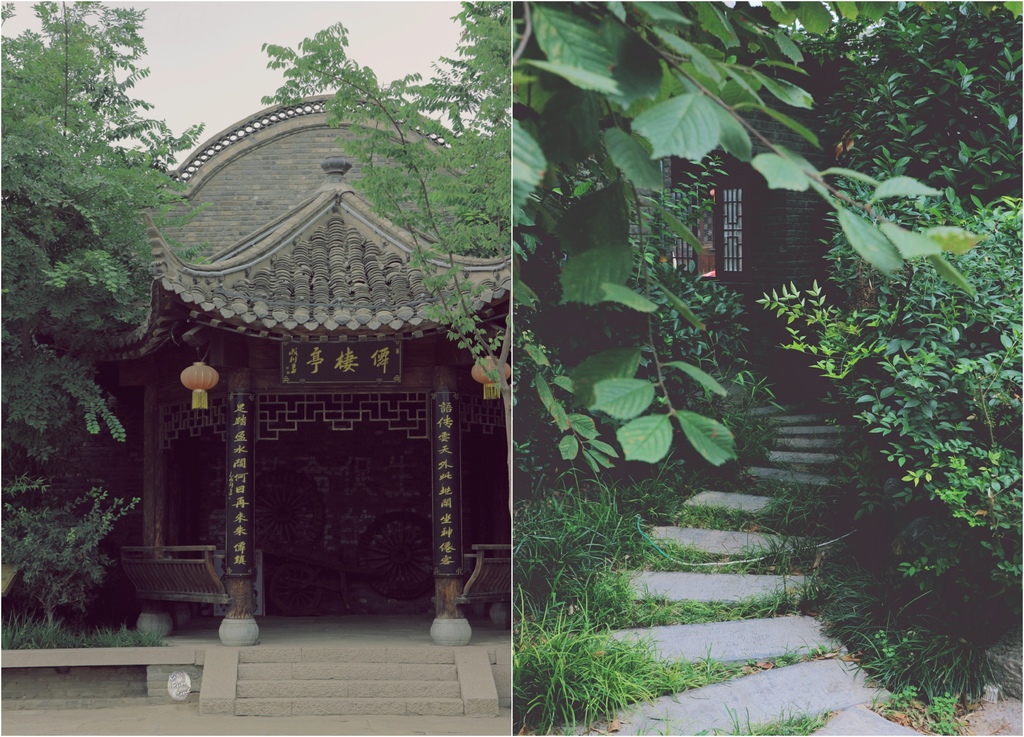
The Origin of Zhuxian Town
The origin of Zhuxian Town is related to a person named “Zhu Hai”. Zhu Hai, who was born in the Xianrenying village in the south of Kaifeng City, was smart, diligent, and had a talent for martial arts from a young age. The village Xianrenying was originally called Zhu-Ying. So, why is it later changed to “Xianrenzhuang”? And why did Juxian Town change its name to Zhuxian Town? It all began with the Qin State.
During the Warring States Period, Qin State attacked Zhao State. As Zhao was losing, it asked Wei State for help, and Wei issued 100,000 reinforcements. However, when the soldiers came to the national border, they were too afraid of Qin to move any forward.
During which, there was a man called “Ping Yuan Jun” (referred to as Ping below) in Zhao State, whose wife was the sister of “Xin Ling Jun” (referred to as Xin below)from Wei State. Ping wrote several times to ask Xin to urge the emperor of Wei State to make a war to Qin State, while the emperor never made a response. Therefore, Xin decided to go to Zhao State in person as he couldn’t leave his sister there alone.
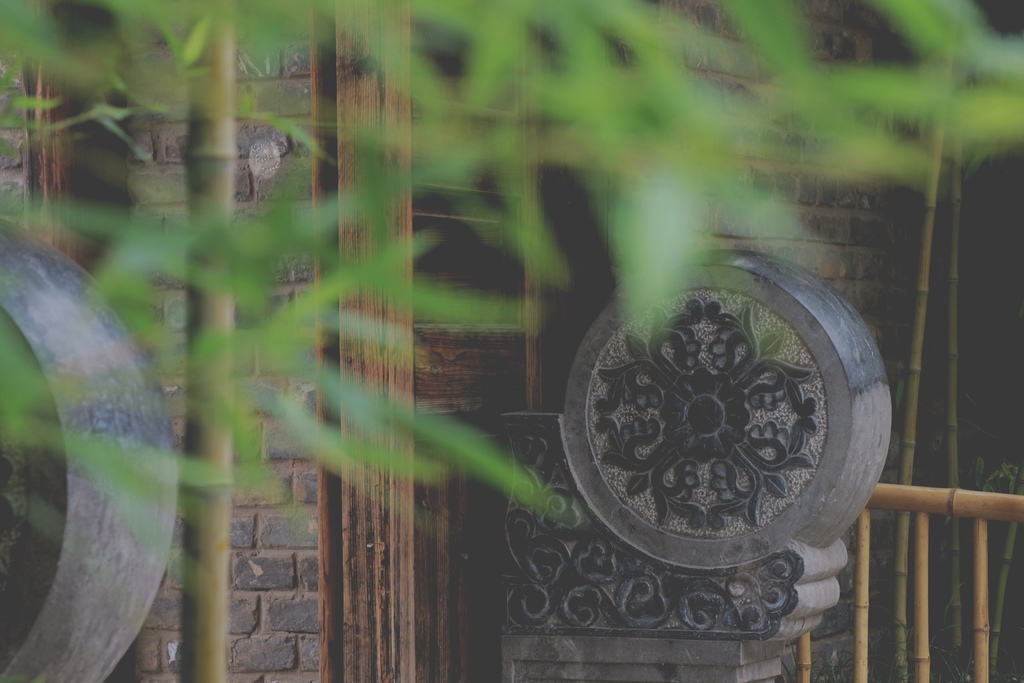
When Xin passed Wei State on his way to Zhao State, he went to see his friend “Hou Sheng“(as Hou below).
Hou said, “You’ve such a good friend to me, and now how can I stand by and see you put yourself in such a danger!”
Xin then asked, “Well, do you have any good ideas?”
Hou said, “I’ve heard that the Wei emperor likes one of his wives, Ru Ji. And I also know that her father was killed, and it was you that helped her kill the murderer, is that true?”
Xin said, “Yeah.”
Hou said, “That’s great. Since Ru Ji has always wanted to return your kindness, you should ask her to stole into the emperor’s room and steal the commander’s seal, she would definitely agree. Then, I have a friend called “Zhu Hai” who is strong as a cow. With this man and the seal, you could take over the military power of Wei State and save Zhao State!”
Xin was so excited after hearing this plan, he shouted, “Niceeeee!”. And Ru Ji indeed followed his order and succeeded in stealing the seal. (Me murmuring: “Wait, wasn’t that a bit too easy? Was the emperor littered the seal as socks or what?”)
Anyway, Xin and Hou went on to find Zhu Hai. Hou told Zhu Hai, “If Wei’s General refuse to hand you the military power, you should kill him and take over the army (me again: “Wait, was this reasonable?). Zhu Hai promised (me: “Wait, wouldn’t the promise too and this promised too rash?”)
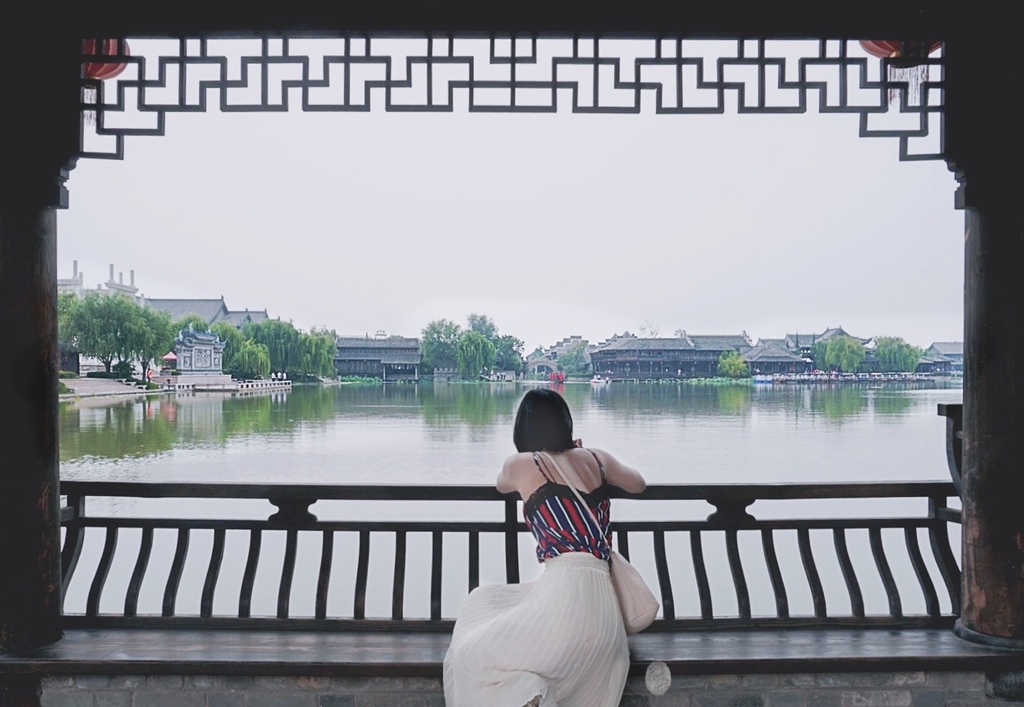
On the same day, Xin came to the national borderline and lied to the Wei’s General, ” the emperor said you have been hard work for a long time, and nom I would take your place to save Zhao State.”
The General held doubts and hesitated, “Hmmm…well…I would like to confirm with the emperor…” When he didn’t even finish his sentence, Xin gave Zhu-hai an eye, then, Zhu-Hai raised a huge hammer and shouted, “The General does not follow the emperor’s order, I shall punish you!” and then he killed the General with a beat (me:” Hey wait! Wouldn’t the general too weak to deal with?).
In the end, they attacked the Qin State’s army at night and won a victory. Ping was very grateful to Xin and Zhu-hai thus honored Zhu-hai as “Bailihou”. After this news spread, villagers in Zhu-Ying thought that Zhu-hai was a god thus changed Zhu-Ting to “Xianrenzhuang”. Later, Zhu-Hai moved to Juxian Town, and people then changed it to “Zhu-xian Town”, which is the origin of the town.
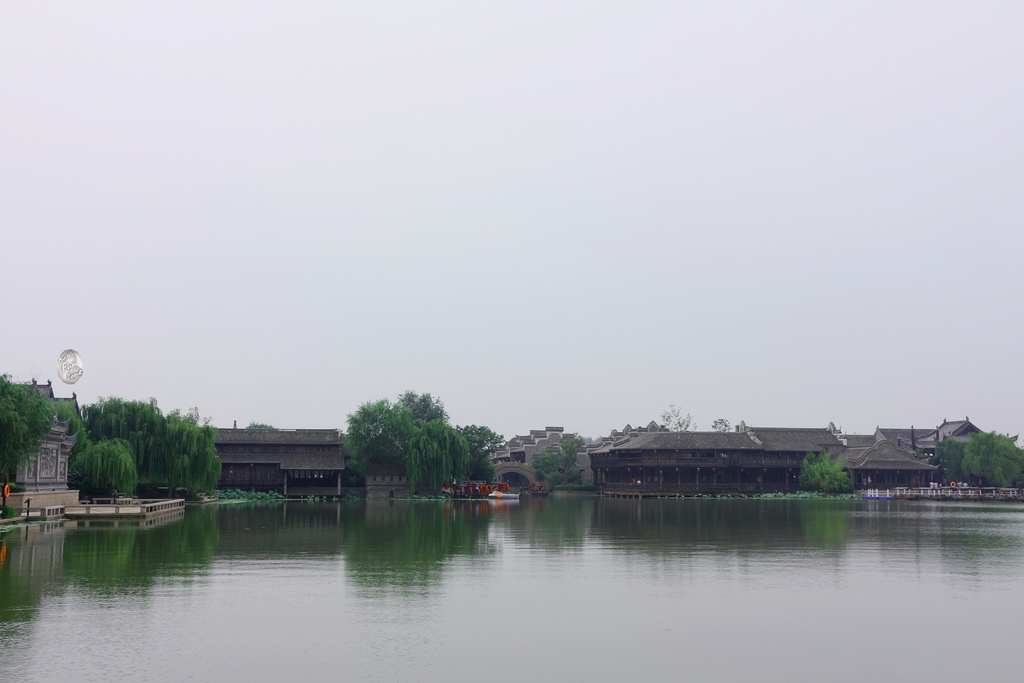
The Development of Zhuxian Town
Archaeological excavation proves that there had been traces of human activities around Zhuxian Town as early as five or six thousand years ago.Since the Tang and Song Dynasties, Zhuxian Town has been the transportation and commercial center of northern China, and it came to its first prosperity due to the river transport. Although it once declined in the Jin and Yuan Dynasties, it had risen again because of the development of the river by the end of the Yuan Dynasty and the early Ming Dynasty.
Being the shipping destination, Zhuxian Town has become the only port that connected to foreign countries in Kaifeng. This made it indispensable to Kaifeng and also established its status as one of the “Four Famous Towns” in China. However, after the middle of the Qing Dynasty, due to the overflow of the Yellow River and the transfer of traffic routes, Zhuxian town lost its advantage for water transport.
And by the beginning of the 20th century, not only was the business shrinking sharply, but towns were also ruined by floods, sandstorms, etc. During the period of the Republic of China, due to civil wars and Japanese invasions, Zhuxian Town’s economy collapsed completely. By 1938, the population of the town was merely 7,000 left, less than one-twenty fourth of its heyday. The houses had been torn down by four-fifth, and a large number of ancient buildings were destroyed. The Qifeng Guyuan now we see is a theme park for rebuilt antique buildings of Zhuxian Town.
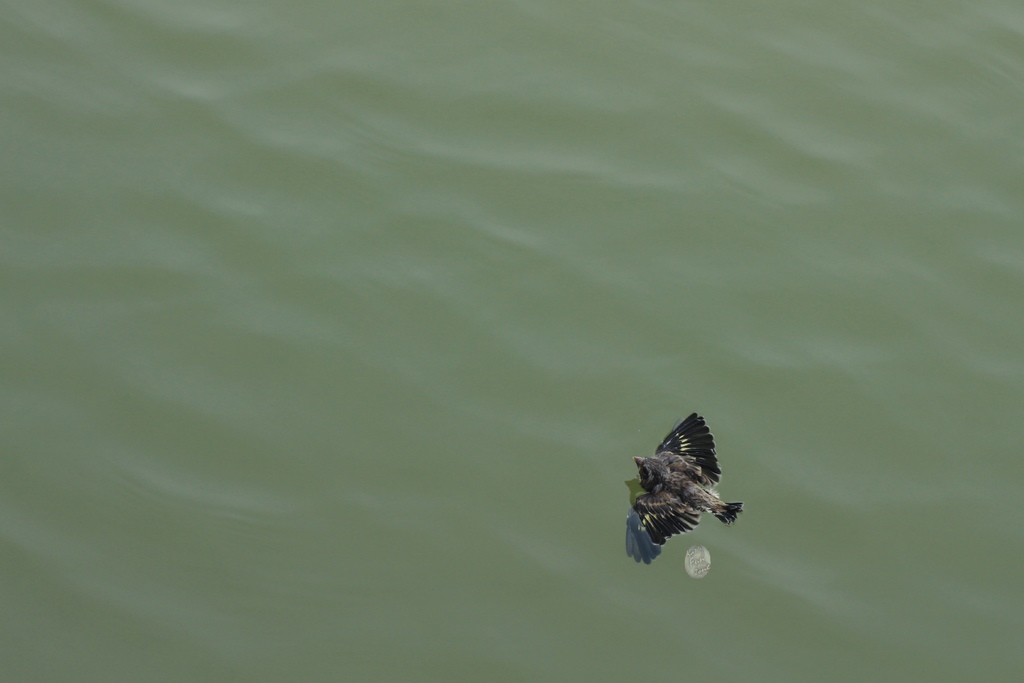
The Arrangement of Qifeng Guyuan
The major difference between the Qifeng Guyuan and the Qingming Shanghe Yuan is that the most important part of the former is its water activities, and it is the only tourist park that features water ancient town in the Central Plains area.
As you pass through the main entrance, you can see the lake that occupies over half of the area of the park. Images of the green willow trees and the ancient Chinese houses surrounding the lake reflected in the sparkling water, along with the small bridge and the slowly swaying boats on the other side, bringing a peaceful atmosphere to the park.
The park covers an area of about 3.5 million square meters, with Ming and Qing dynasties as the main style of architecture. It is divided into eight areas, such as an ancient town, the lake, hot spring, show field, and farmhouse DIY, etc. There are four phases for the ten-year project of the park. After the completion, it is expected to represent the scenario of the heyday of Zhuxian Town.
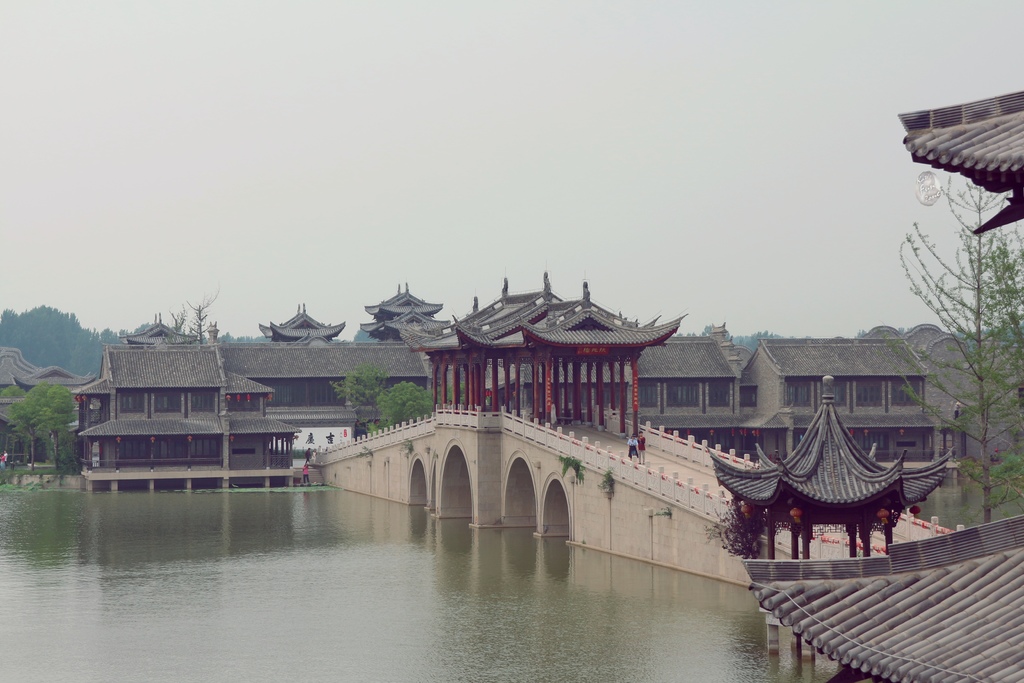
Zhuangyuan Bridge, which is total hand-carved, took ten months to complete. The stone used is from Qiaotou Town (in Wulian County, Shandong), which is known as the “Best town of Jiangbei Stone”.
During the Song Dynasty, Zhao Kai, the third son of the Emperor “Huizong”, loved reading. He secretly participated in the Imperial Examinations. And he turned out to won the “Zhuangyuan” (the first place of the examination)! After the release of the result, Zhao Kai told his father the truth. Although the emperor was very happy about the news, he also worried that the other participants would hold doubt about the result, thus taking the “Bangyian” (the second place) as Zhuangyuan.
Afterward, the Emperor gave Zhao Kai thousand of gold to encourage his sons to study harder. Zhao Kai donated the money to the area of Zhuxian Town, where was severely damaged by the flooding of the Yellow River, under the name of the imperial Song. He also built a bridge, which the people called it “Zhuangyuan Bridge”, commemorating the most noble “Zhuangyuan”, Zhao Kai, in Chinese history.
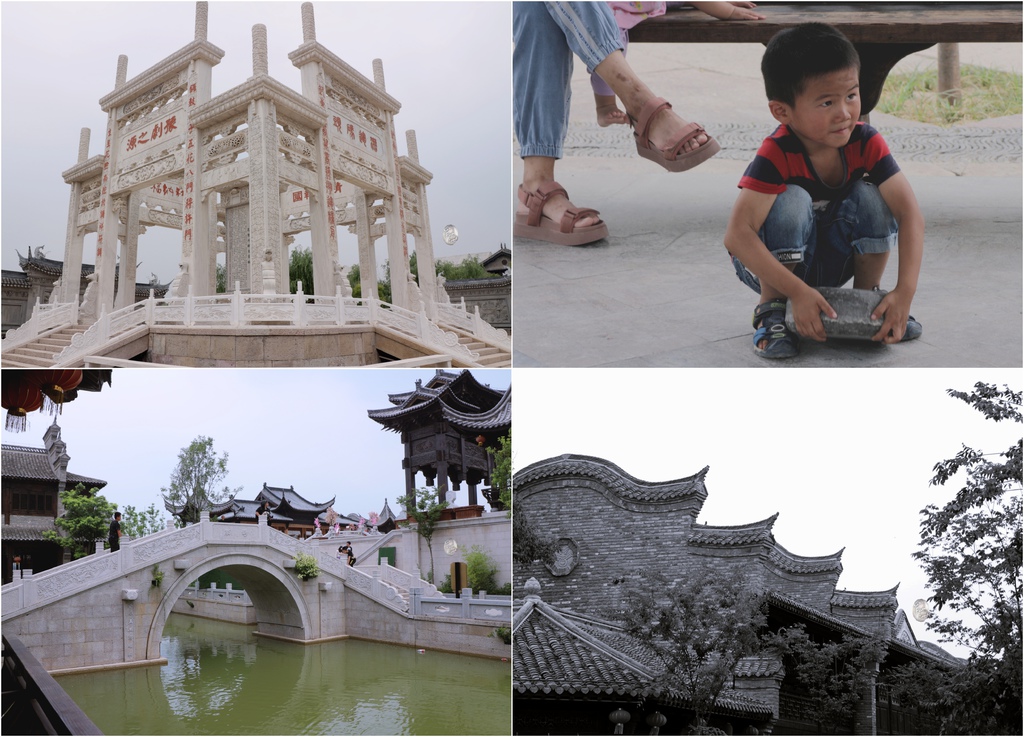
▲ Magpie Bridge(Lower left)
There is also an interesting story about this bridge, which is related to the Zhao Kai we have mentioned above.
It is said that one day when Zhao Kai took a trip to the Magpie Bridge, he met a lady who was the daughter of a wealthy merchant, Zheng. They fell in love right away. However, Zheng said he would not marry his daughter to anyone besides “Zhungyuan”. So, that’s why we have the story the Zhao Kai went to participate in the Imperial Examination to win the Zhuangyuan(1st place)!
▲ Buoyi Guangchang (“Competition Plaza”)(Upper right)
There is a Competition Plaza in the park. In the middle was a pavilion, with a giant version of the Go chess on the floor (that is, the one held by the boy in the pic).
This square was built to commemorate the originator of Taoism – Guiguzi. When Guiguzi and his disciples practiced in Zhuxian Town, the life there was so boring that one of the disciples couldn’t bear it, thus he often sneaked out and play Go chess with other people.
Finally, when Guiguzi found out, he realized that disciples needed to relax occasionally; therefore, he sometimes brought his disciples to play chess here. The disciples also gripped a lot of inspiration of philosophy in the game and succeeding turning into gods (my murmur: what…??). So, people later called this plaza “Buoyi Guangchang” (Competition Plaza).
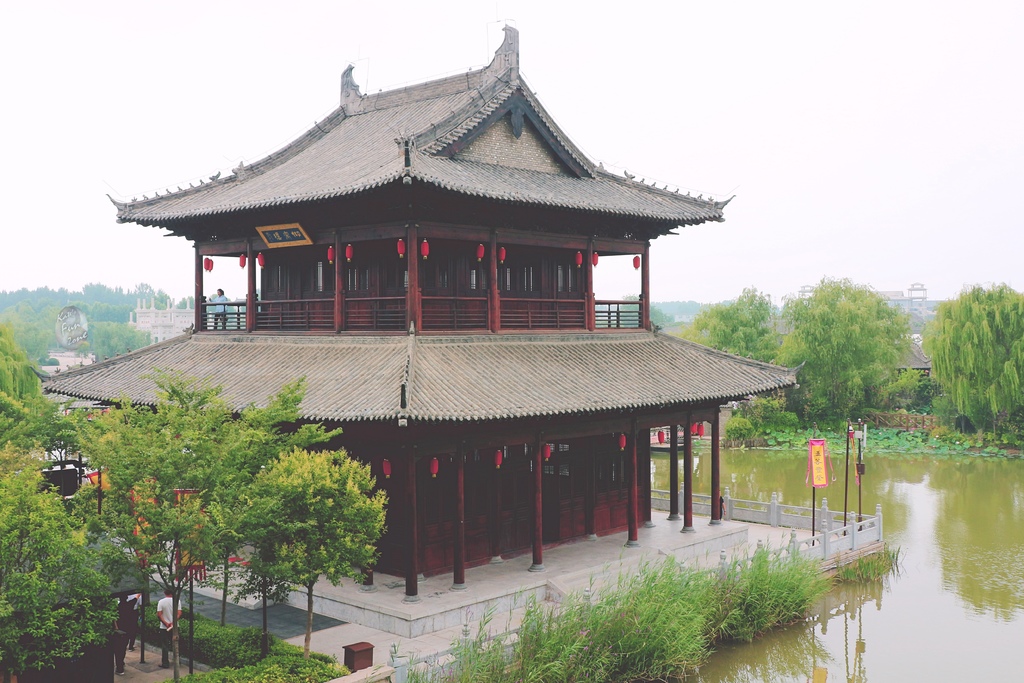
This building is an institution set up, by the ancient Chinese government, in areas where collected grain. It is responsible for grading and registering the grain that had been paid by the local authorities each year.
Chinese Traditional Wedding
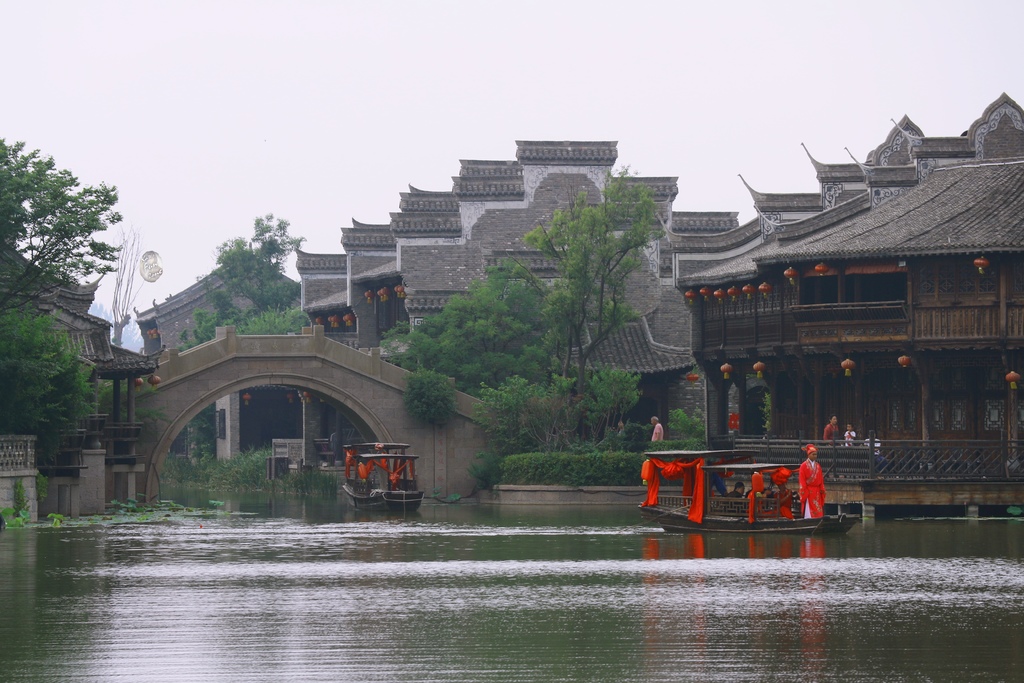
When walking in front of the Yanyang Lou, I happened to see a bride wearing a traditional Chinese red wedding robes, and a Phoenix Coronet coming out from the building. At first, we thought it was a show designed by the park– probably because the bride was beautiful enough to be an actress–. We and a group of tourists stood there excitedly watching the “show”, but as it progressed, I realized, “Hey, this is a real wedding ceremony!” It was so lucky for us to see a traditional Chinese wedding, like the ones we’ve seen in Chinese dramas, in person.
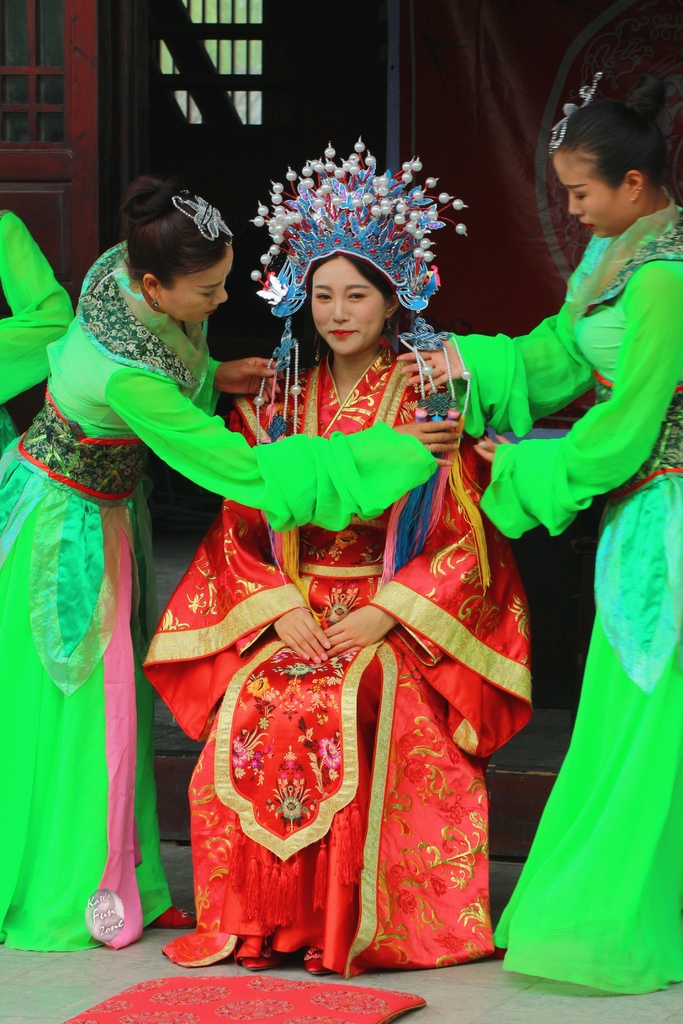
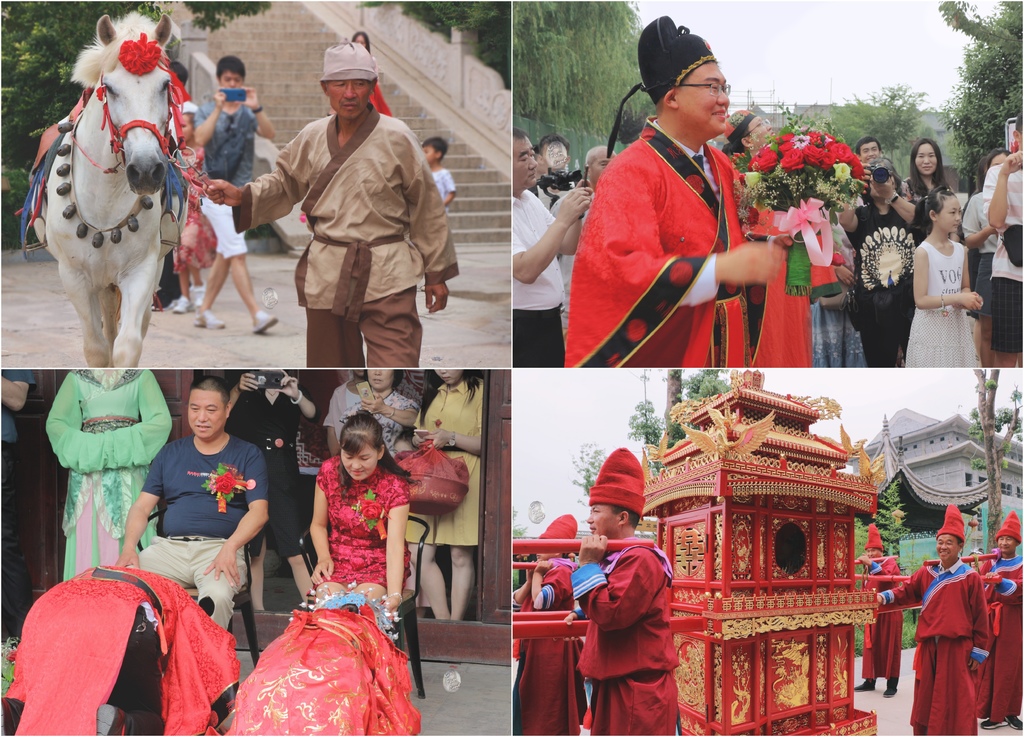
The bride went back into the building after a short while. At this moment, there were some noises behind us. I turned and found out– Aha! Comes the Prince Charming! The groom was coming riding a white horse, followed by a wedding band which played all kinds of Chinese instruments.
The groom was also in a red gown, with a “Zhuangyuan hat” on his head, and a bouquet of gorgeous red roses in his hand. Beside him stood a few friends of him. They walked to the closed wooden door and began to knock hard on the door, but the door remained tightly closed in silence. This intentional difficulty for the groom is one of the traditions of a Chinese wedding. Only after coping with the difficulties could the groom pass to see his wife. So, we watched them pushed and squeezed so hard at the door, and finally they managed to squeeze out a slight crack between the doors, “Bang!” The guys squeezed harder and rushed into the building.
Soon after, the couple showed up again together. After kowtowing to their parents, the bride’s face would be covered by a red veil, then the groom held the beautiful bride in his arm on to the bride’s sedan.
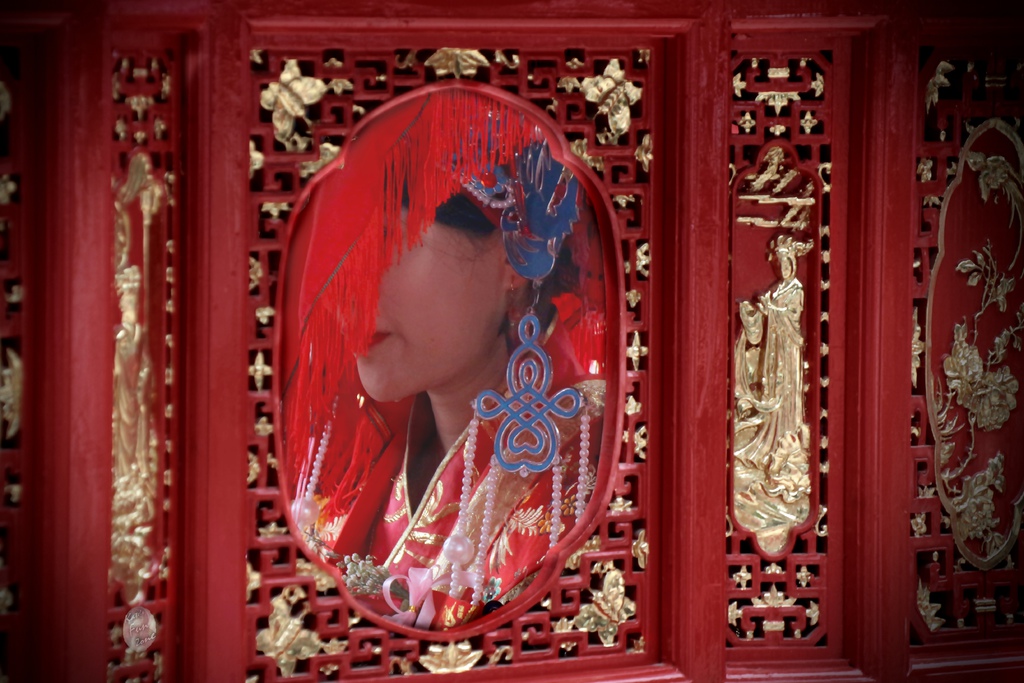
This bride’s sedan is the most exquisite and beautiful one, comparing to the few others I had seen during the trip. Through the carved windows on both sides of the sedan, we can see the bride’s red lips and cheek under the red veil, which made her more mysterious and attractive.
The sedan carriers held up the sedan. The groom once again got on the white horse and walked forward of the sedan. The wedding procession was a long team, with musical and dancing groups taking the lead. Behind and on both sides of the procession were the family and friends of the couple, but there were more people like us, who were just happened to see this wedding.
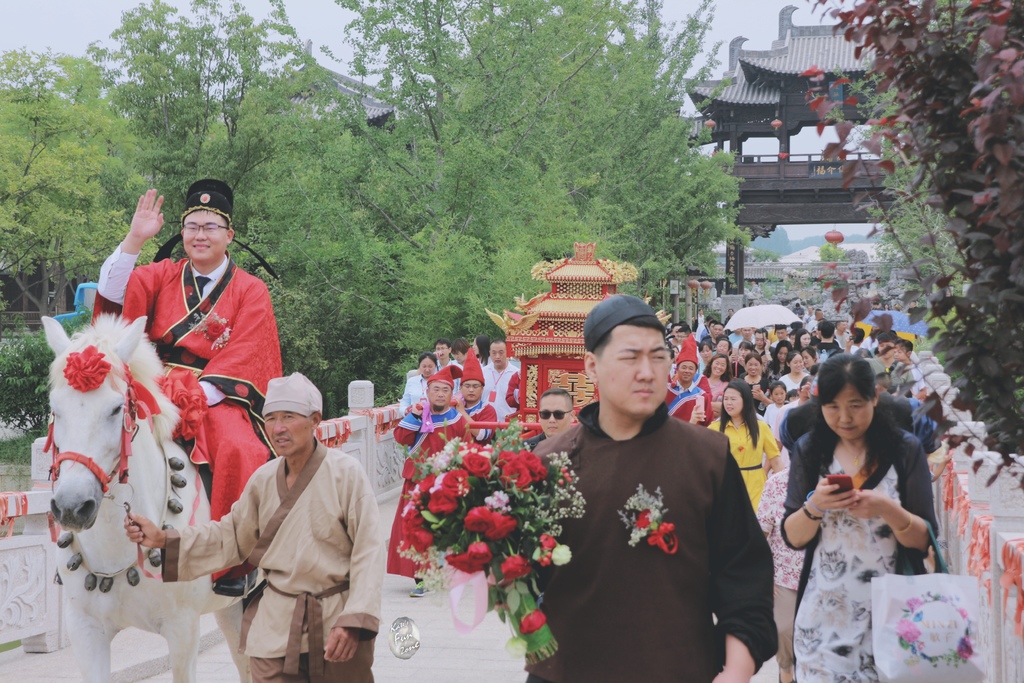
The procession left Yanyian Lou and crossed the Zhuangyuan Bridge. The groom was very enthusiastic, he kept smiling and waving hands to the crowd, saying, “Thank you, thank you all.” He was being so polite that we were kind of embarrassed as we were just passerby after all :P.
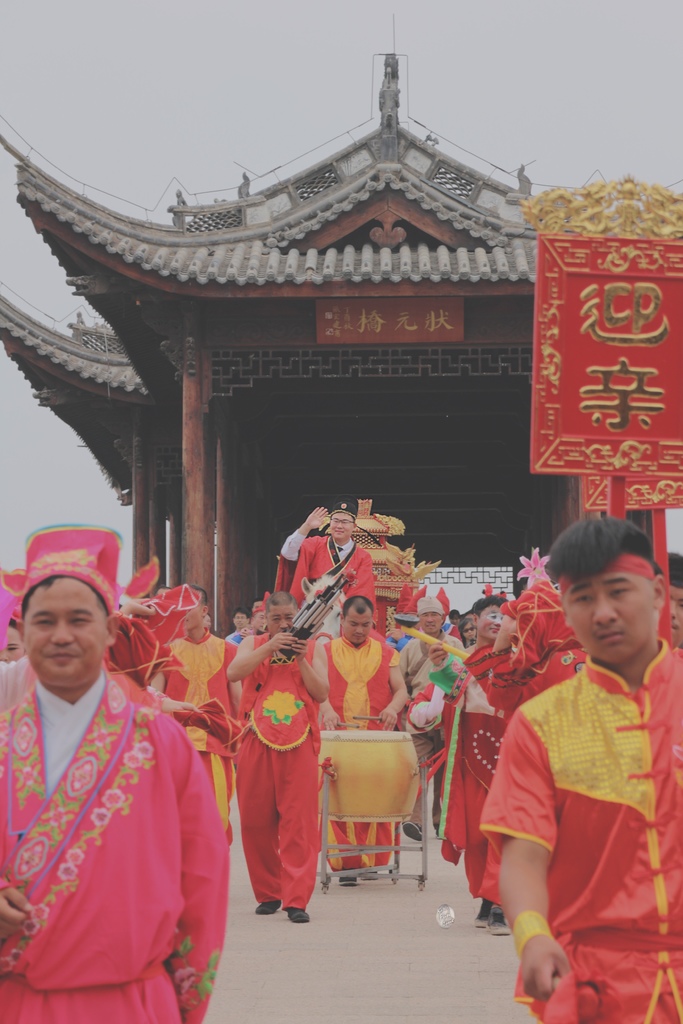
After crossing the bridge, the procession came to the dock by the river, and there stopped a few wedding boats decorated with red ribbons. The groom led the bride out of the sedan and on to the ship. They both turned around to greet and waved at the crowd on the shore, then slowly floated away with the boat.
What was interesting was that I and my group members–which consisted of bloggers and photographers–each held a camera, one bigger than another, in hand. All of us followed the procession closely from the beginning to the end.
We, 12 people, 12 cameras, surrounded the couple at the dock, striving desperately for the best position for the photo, probably work even harder than the photography team that they hired LOL, which resulted that they mistook us as members of their photo team lollll.
They might wonder in surprise, “Wow, this photography team we invited is really quite big.” While being confused when they check the photos afterward, “Strange…how come there were dozens of cameras taking photos but the number of photos turns out to be only a few?”
And for us, we turn out to find it is by no means an easy task to be a wedding photographer LOLLLL.
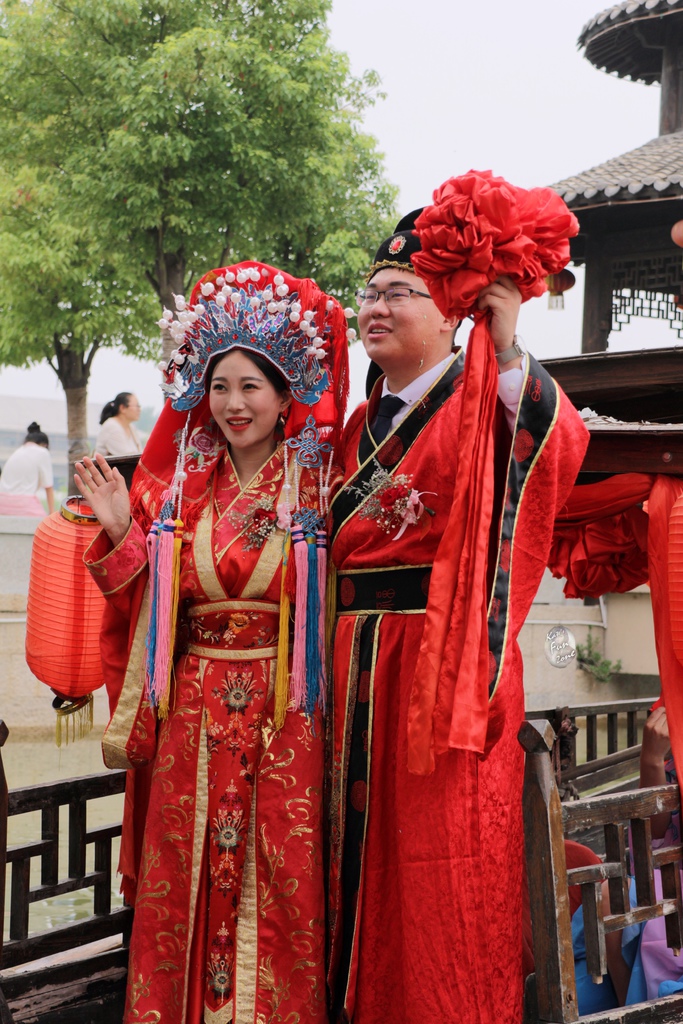
The park was really beautiful as a whole. Plus, there weren’t too many tourists that day, which was perfect for taking nice pictures (like the one below). There was also a team here to film that day.
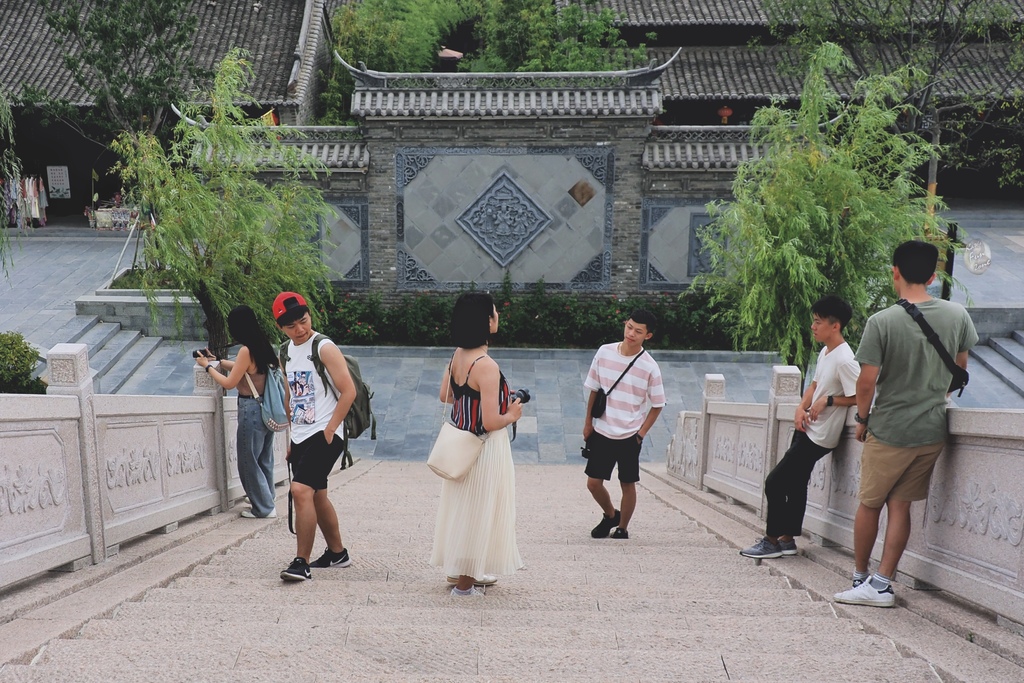
However, compared to Qingming Shangheyuan, there are fewer entertainment activities here. Except for the wedding, I didn’t see other shows during our stay.
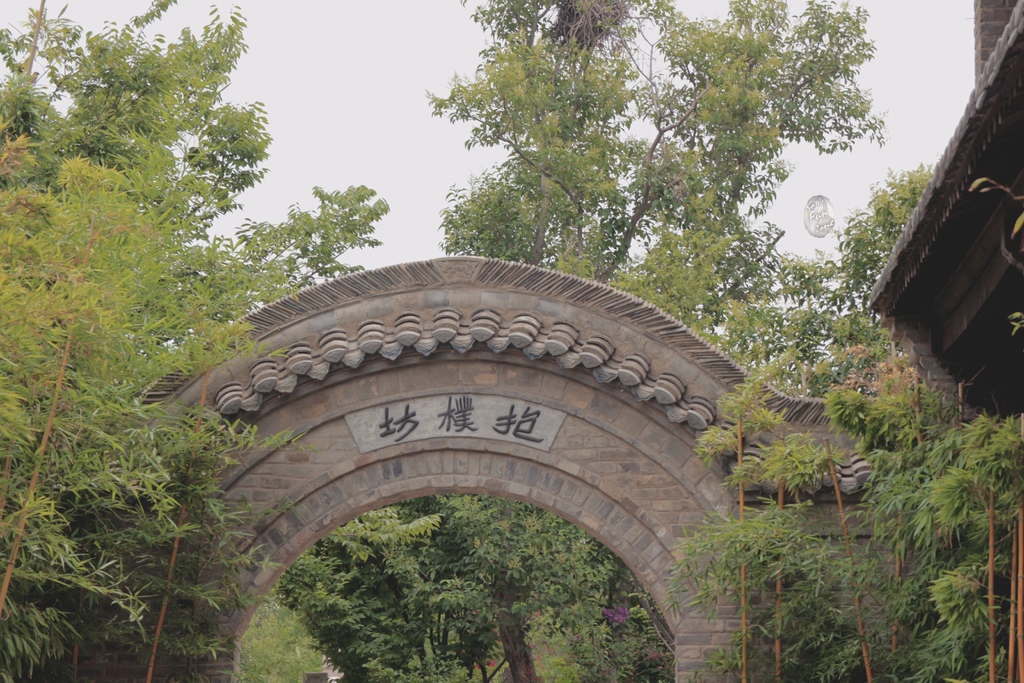
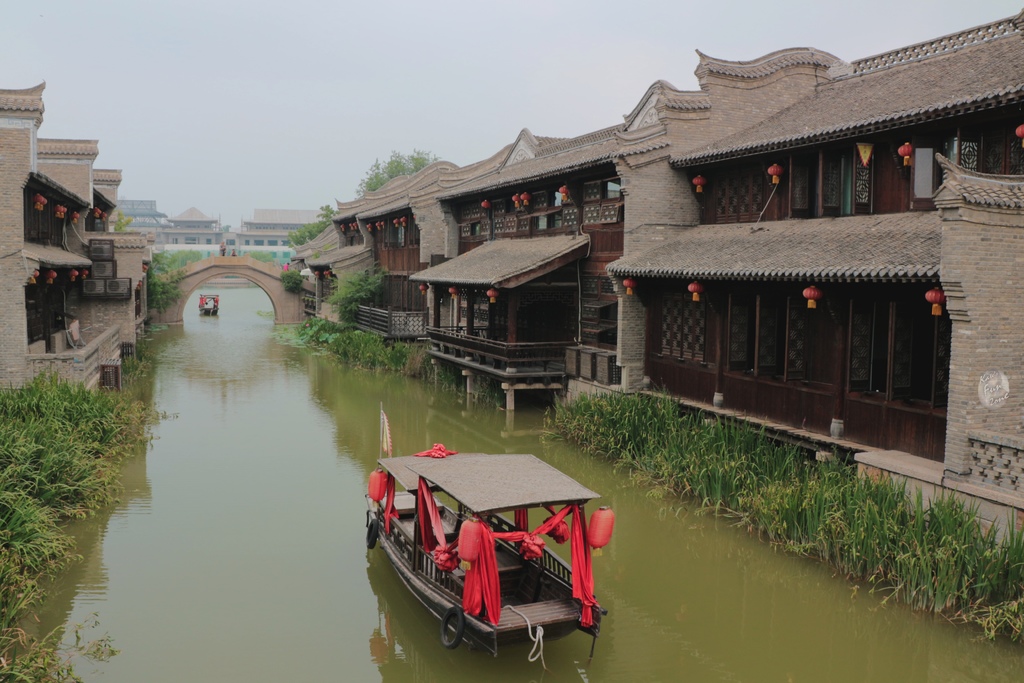
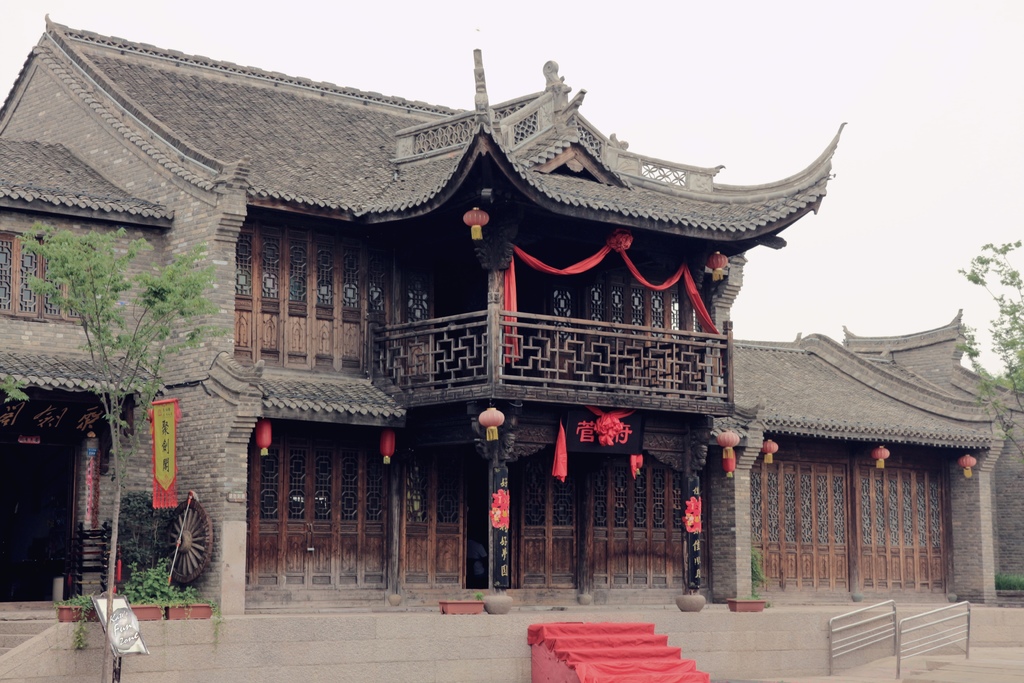
▲ Tell you what, we saw a “Qing Lou” (traditional Chinese bawdy house) on the signboard of the park. Following the instructions, however, we could not find a building that very building. Finally, we found out that it was this building shown above–the plaque written “Qing-lou” at the door was changed to “菅府(Yu-fu”, meaning the house of Yu family, because of the wedding today.
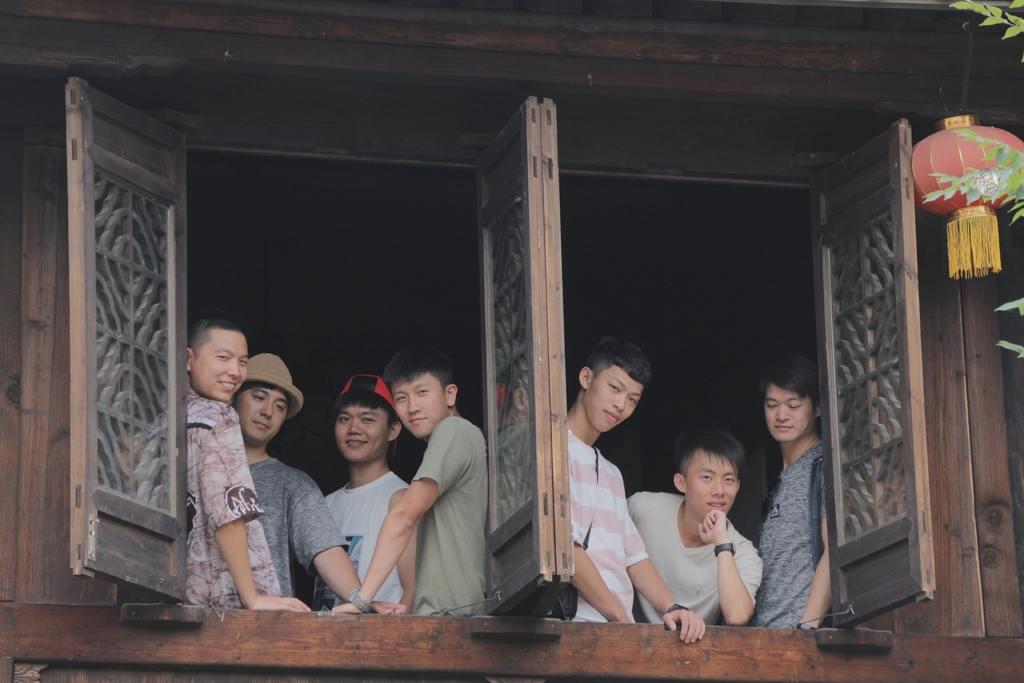
Across from the “Qing Lou”, there is also a “Qifeng Inn”, a two-story antique building, which is available for tourists’ accommodations here in the park.
A beautiful long row of wooden windows attracted our attention. Not knowing who gave the idea, suggesting that all the males in our group to go up to the window for photos. We originally expected to create an idol-like scenario, while it ended up, after seeing them standing there, omg, not feeling right, honestly XDDD.
Kaifeng Traditional Artcraft — Chinese New Year Woodblock Print
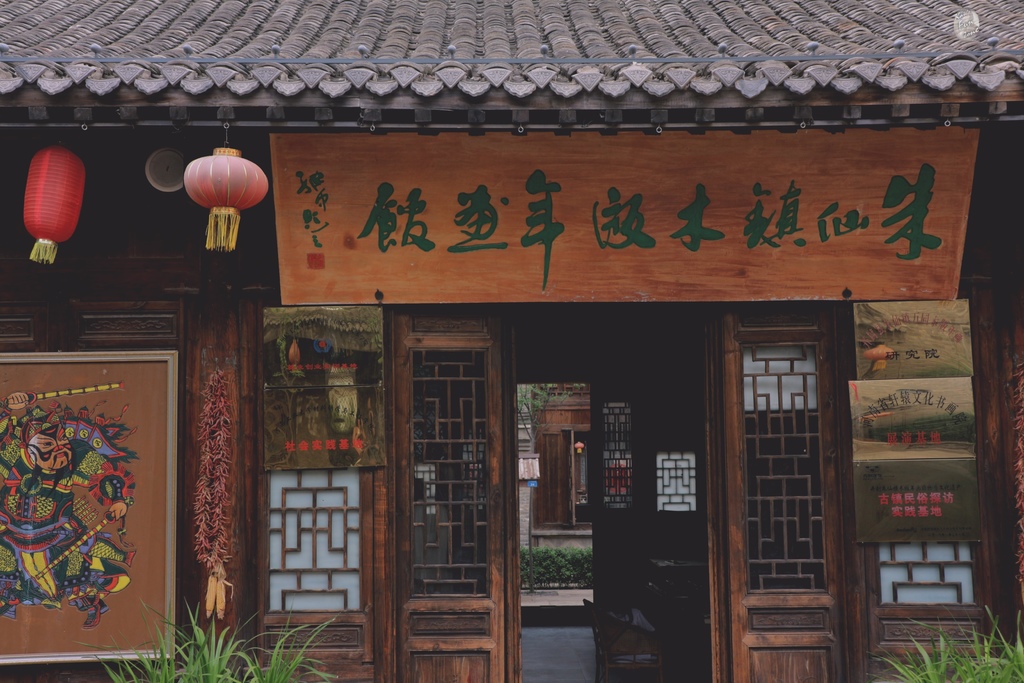
Our final spot, before leaving the park, was to experience the DIY of “Chinese New Year woodblock print“, the so-called woodblock print is a traditional printing method, which uses the wood board to print out the new year paintings (*). ZhuXian Town is the origin of Chinese New Year woodblock print and is known as the “Hometown of Chinese New Year Woodblock Print Art”.
* Chinese New Year print: Folk paintings used to ward off the evil and recruit fortune.
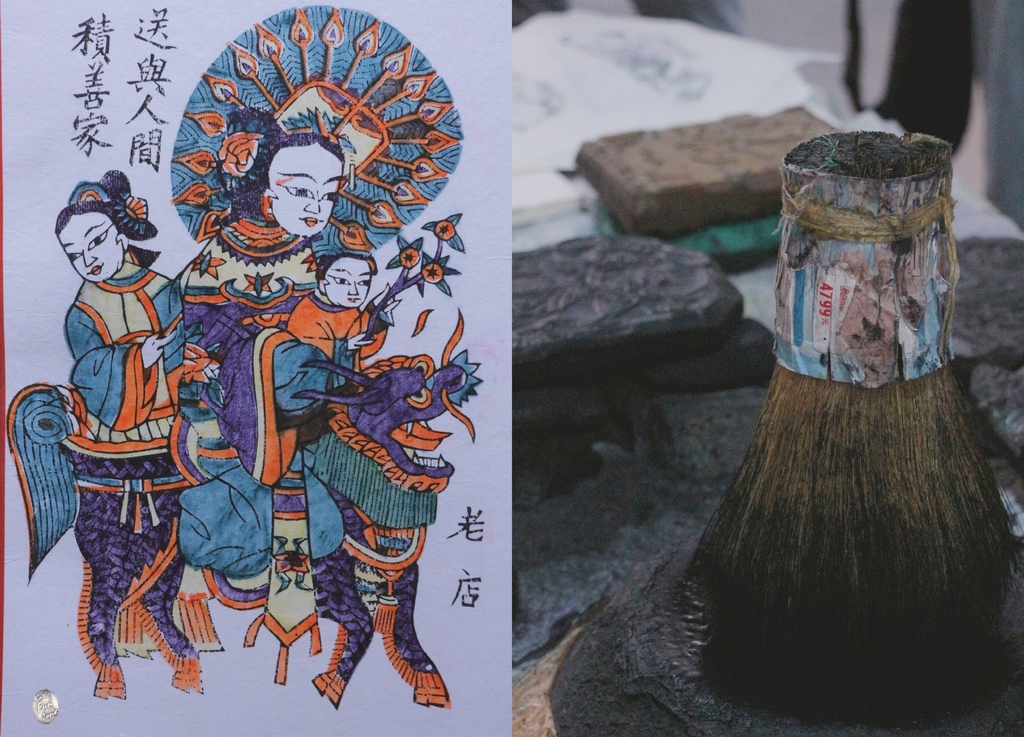
There are several characteristics of woodblock print:
- Bright colors: Using minerals and plants as materials, the selected colors are mainly red, orange, purple, green, blue and other saturated and bright colors, and the characters tend to be simple and exaggerated.
- The full composition of the painting: The picture is full, symmetrical, and compact; the lines are rough and concise, and the characteristics of the area are distinct, featuring the simplistic, enthusiastic aesthetics and characters of the villagers.
- Easy understanding: The subject and characters of the picture are mostly from folk stories, myths, operas and highly respected heroes.
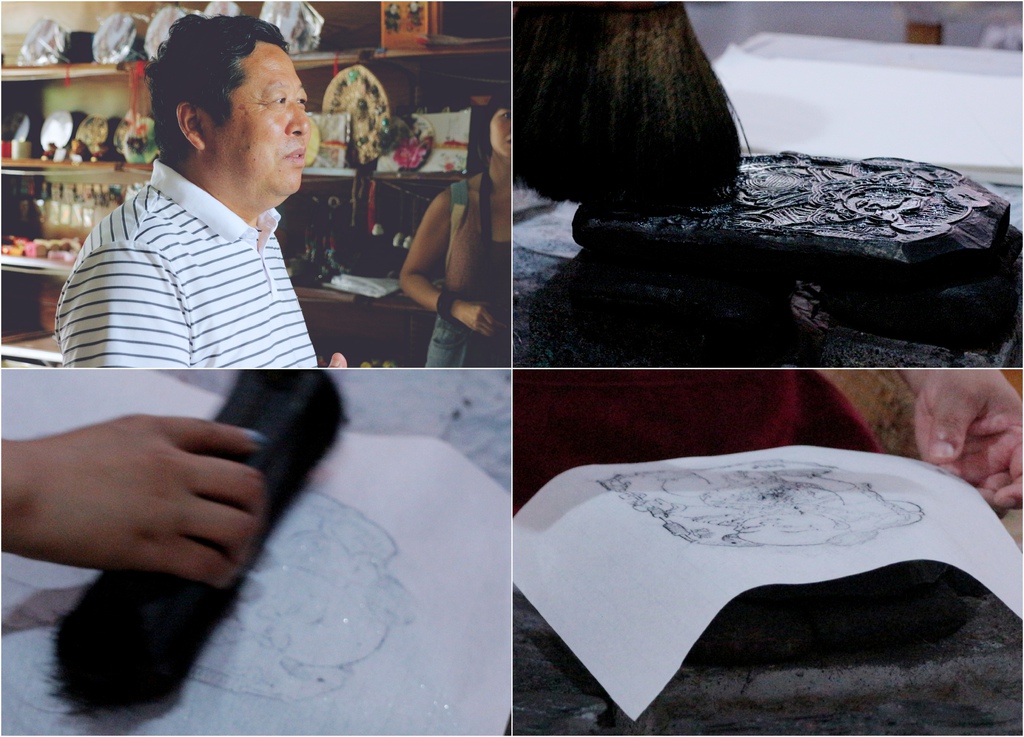
The master showed us the most basic printing process:
Firstly, brush the ink with a special brush–it is said that it can be used for ten years–. Second, coated the rigid board with ink, a step that seems easy while requires good skill: it needs to be evenly coated, it would go blurred if too wet; go blank if too dry. Finally, cover the board with paper and use a long brush to brush over the paper gently.
It seemed an easy task until we tried it ourselves, realizing that every step requires good skills. It is really difficult to print a beautiful print.
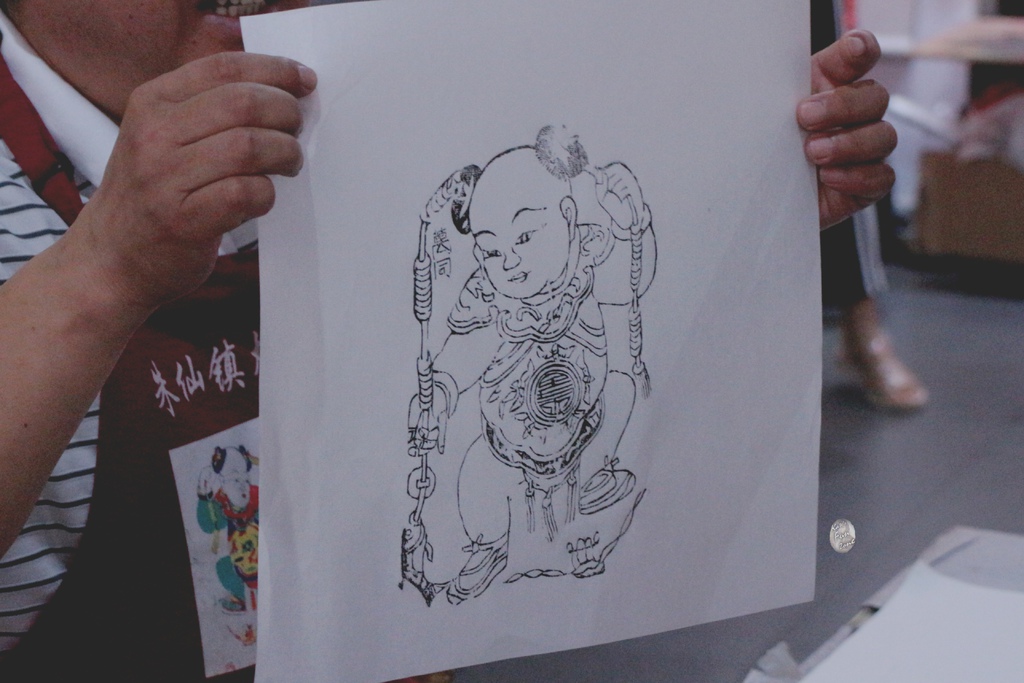
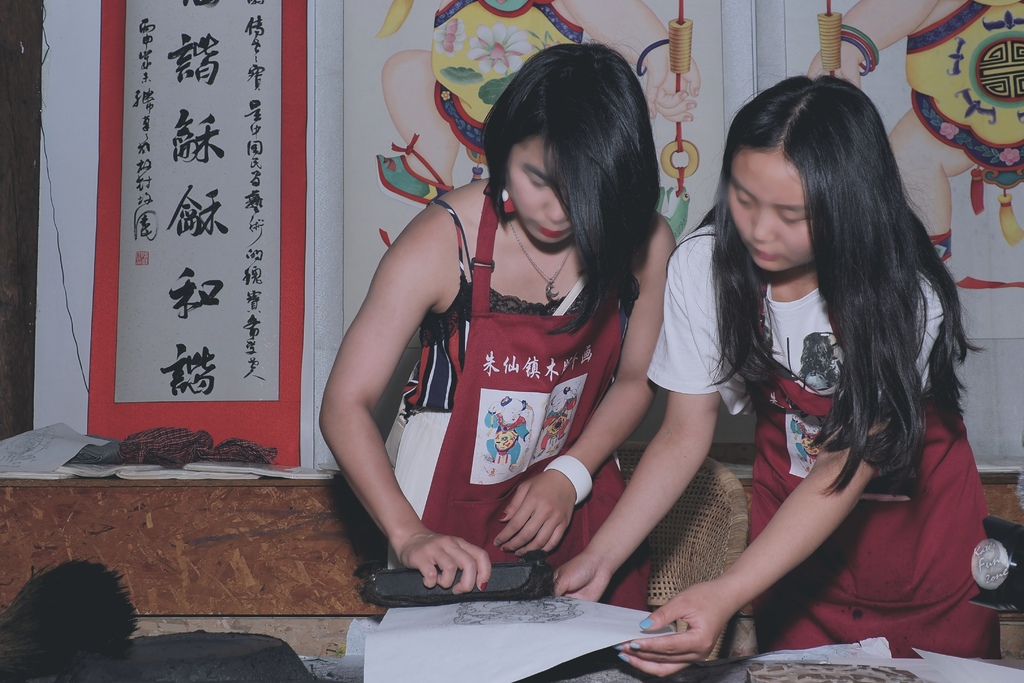
The lines should be clear, and the amount of ink should be just right. Only when satisfying these two tips can a qualified paint be done. According to the master, for a senior painter, there could only be 1 to 2 failures in 200 pieces of works, which is amazing.
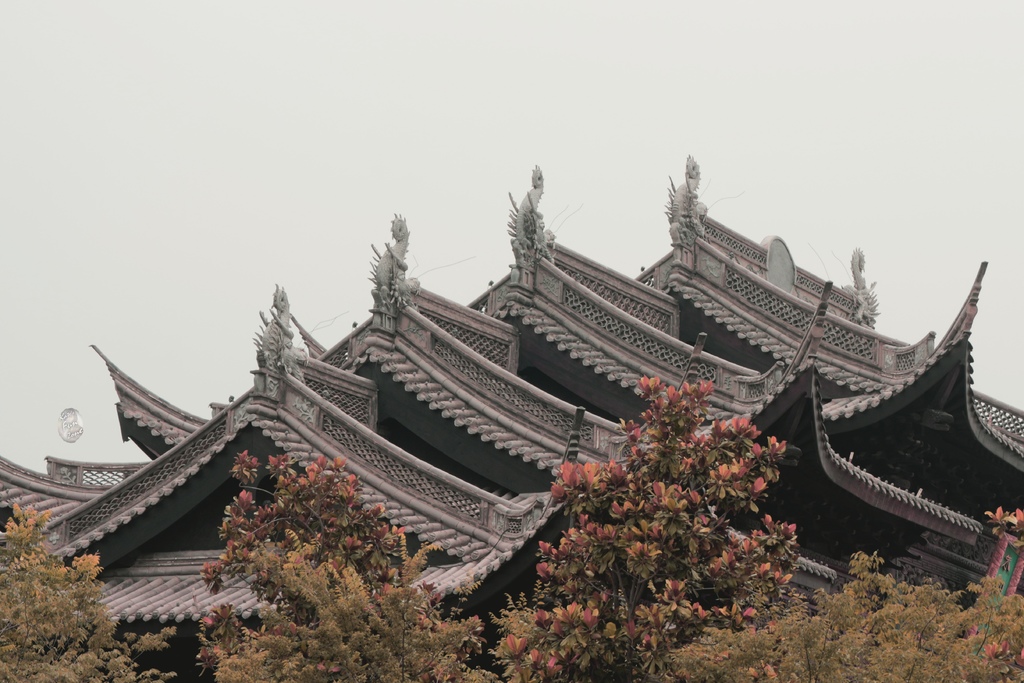
Tourist Site Info
- Address:West Bank of Grain River, Zhuxian Town, Kaifeng City, Henan, China
- Tel: 0371-2676-0111
- Opening hours: 09:30-17:00
- Tickets: RMB 50/adult; 25/child
- Official Website
📌 Henan Tourism Coupon
🏠 Accommodation
Agoda|Trip.com|Booking.com|Hotels.com
✈️Tickets
🗺 Trip Planner
📌 Henan Travel Guide
【Kaifeng】 QiFeng-Guyuan– Beautiful Chinese Ancient Town.
【Kaifeng】MILLENNIUM Park – Song Dynasty AncientPark.

